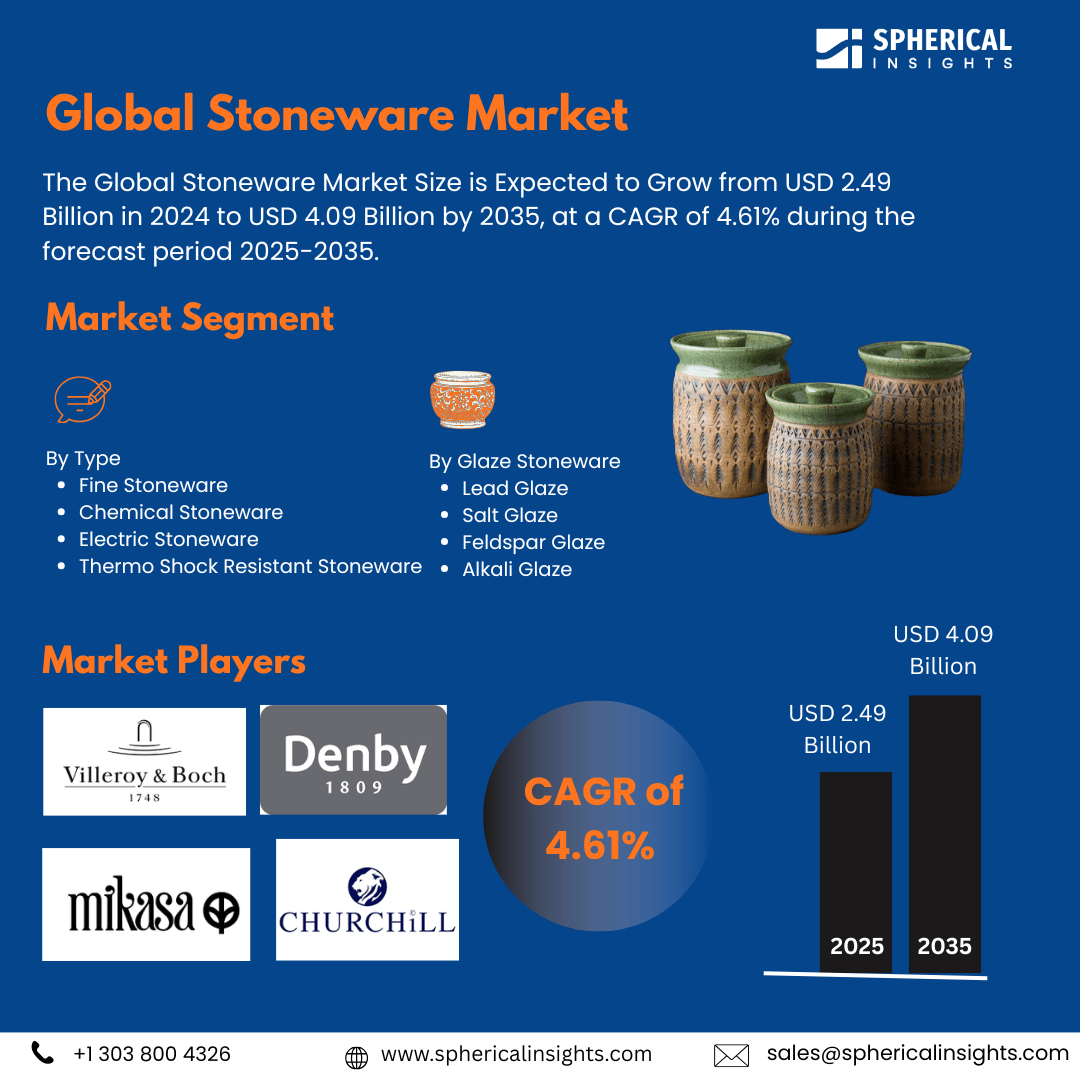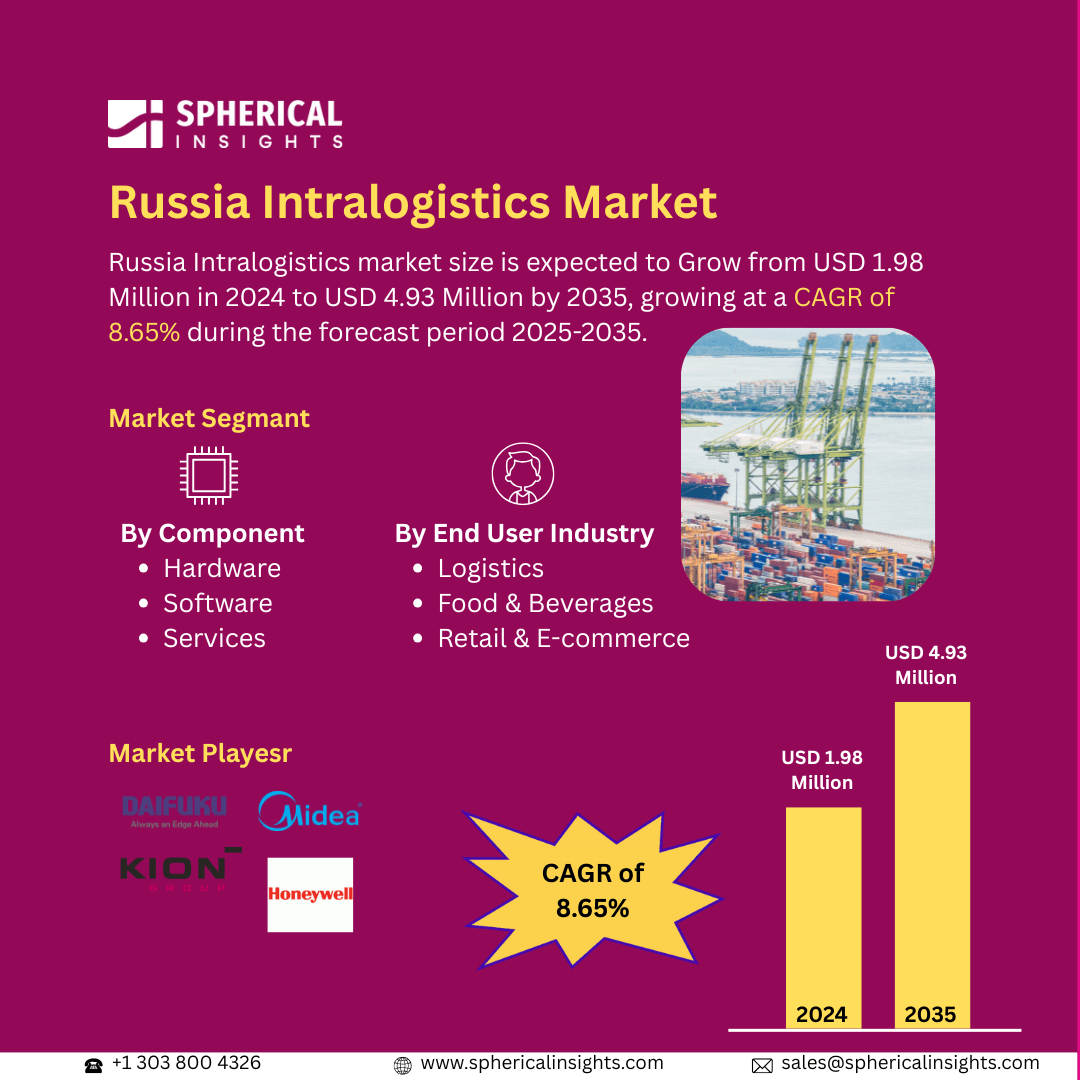Stoneware Market Summary, Size & Emerging Trends
According to Spherical Insights, The Global Stoneware Market Size is Expected to Grow from USD 2.49 Billion in 2024 to USD 4.09 Billion by 2035, at a CAGR of 4.61% during the forecast period 2025-2035. The global stoneware market is experiencing growth due to increasing consumer demand for durable, aesthetically appealing, and eco-friendly tableware and home decor products.
Key Market Insights
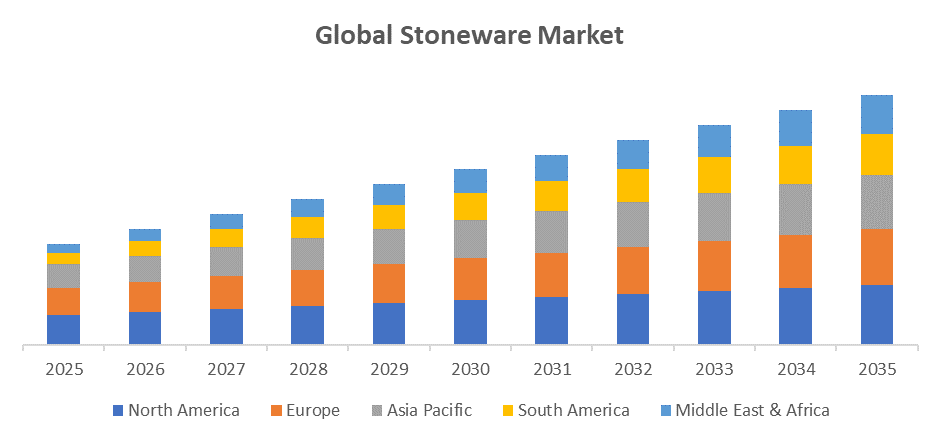
- Asia Pacific is expected to account for the largest share in the stoneware market during the forecast period.
- In terms of type, the fine stoneware segment is projected to lead the stoneware market throughout the forecast period
- In terms of glaze stoneware, the salt glaze segment captured the largest portion of the stoneware market
Global Market Forecast and Revenue Outlook
- 2024 Market Size: USD 2.49 Billion
- 2035 Projected Market Size: USD 4.09 Billion
- CAGR (2025-2035): 4.61%
- Asia Pacific: Largest market in 2024
- Europe: Fastest growing market
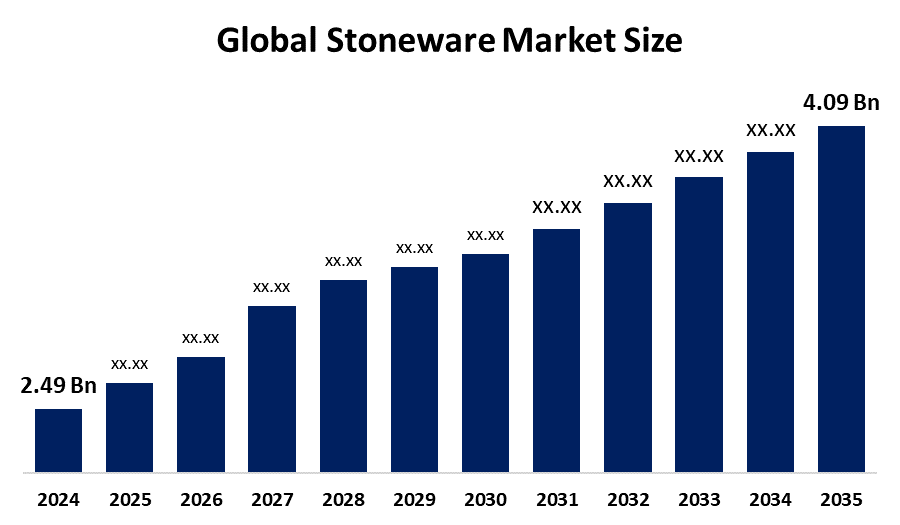
Stoneware Market
The Stoneware Market Size includes the production and sale of durable ceramic products made from clay fired at high temperatures, such as tableware, cookware, and decorative items. Stoneware is valued for its strength, chip resistance, and elegant design, making it popular in homes and the hospitality sector. The market growth is driven by increasing consumer preference for sustainable and eco-friendly materials, as well as rising disposable incomes and urban lifestyles. Governments are actively supporting the stoneware industry through initiatives that promote local manufacturing, provide export incentives, and encourage sustainable production practices. These efforts aim to enhance the quality and competitiveness of stoneware products globally. Additionally, investment in infrastructure and tourism sectors further stimulates demand for stylish and durable tableware. Innovation in ceramic technology and artisanal craftsmanship also contribute to product differentiation and market expansion. Overall, the stoneware market is growing steadily, fueled by a combination of consumer trends, government support, and industry advancements.
Stoneware Market Trends
- Manufacturers are increasingly adopting sustainable practices, such as using recycled materials and reducing energy consumption, to meet consumer demand for environmentally responsible products.
- Innovations in glazing techniques are enhancing the visual appeal and uniqueness of stoneware products, attracting consumers seeking distinctive and high-quality items.
- There is a growing demand for customized stoneware products, allowing consumers to express their individuality and preferences through unique designs and features.
Stoneware Market Dynamics
Driving Factors: Increasing disposable incomes in the stoneware market
Increasing disposable incomes and urbanization boost demand for stylish and functional products. Technological advancements in production and glazing enhance product quality and variety, attracting a broader customer base. Government initiatives promoting local manufacturing, sustainability, and export incentives further support market expansion. Additionally, growing hospitality and tourism sectors increase the need for reliable, elegant stoneware. The trend toward customization and artisanal designs also fuels consumer interest, making stoneware a favored choice in both everyday use and premium segments.
Restrain Factors: High production costs in the stoneware market
High production costs and energy-intensive manufacturing processes can increase product prices, making them less accessible to price-sensitive consumers. Additionally, the fragile nature of stoneware compared to some synthetic materials may deter certain buyers. Limited awareness about the benefits of stoneware in some regions also restricts market growth. Lastly, supply chain disruptions and fluctuating raw material costs can impact production and profitability, posing challenges to consistent market expansion despite growing demand.
Opportunity: Collaborations with artists and designers in the stoneware market
The stoneware market holds significant opportunities driven by increasing consumer demand for sustainable and eco-friendly products, as more people prioritize environmental responsibility. Rising urbanization and disposable incomes, especially in emerging economies, open new markets for premium and artisanal stoneware products. Innovations in design and glazing techniques provide chances to introduce unique, customizable offerings that cater to evolving consumer tastes. The expanding hospitality and tourism industries present a growing demand for durable and aesthetically pleasing tableware. Additionally, collaborations with artists and designers can create exclusive collections that attract niche markets. Government support for local manufacturing and export promotion further boosts growth potential. E-commerce platforms also enable wider reach and direct consumer engagement, enhancing market accessibility and expanding global customer bases.
Challenges: Fragility during transportation in the stoneware market
The stoneware market faces challenges such as high production costs and energy consumption, making products relatively expensive compared to alternatives. Fragility during transportation and handling can lead to damage and increased losses. Limited consumer awareness in some regions restricts market penetration. Additionally, competition from cheaper, synthetic materials like plastic and melamine impacts market share. Supply chain disruptions and fluctuating raw material prices also pose risks. These factors collectively hinder faster market growth despite rising demand for stoneware products.
Global Stoneware Market Ecosystem Analysis
The global stoneware market ecosystem includes raw material suppliers providing clay and minerals, manufacturers using advanced, sustainable technologies to produce durable products, and distributors reaching consumers via retail and e-commerce. End consumers demand eco-friendly, stylish stoneware for home and commercial use. Regulatory bodies enforce environmental standards and trade policies that shape production and market access. This interconnected network drives innovation, sustainability, and growth, ensuring the stoneware market adapts to evolving consumer preferences and global trends.
Global Stoneware Market, By Type
The fine stoneware segment is projected to lead the stoneware market throughout the forecast period, holding a dominant share of approximately 53.13%. Fine stoneware is preferred by consumers for its smooth texture, chip resistance, and elegant finish, making it ideal for both everyday use and premium tableware collections. Its versatility in design and ability to retain heat effectively also contribute to its popularity. As consumer preferences shift toward durable yet stylish kitchen and dining products, the demand for fine stoneware continues to grow, securing its dominant market share of approximately 53.13%. This trend is further supported by innovations in manufacturing techniques that enhance product quality and appeal.
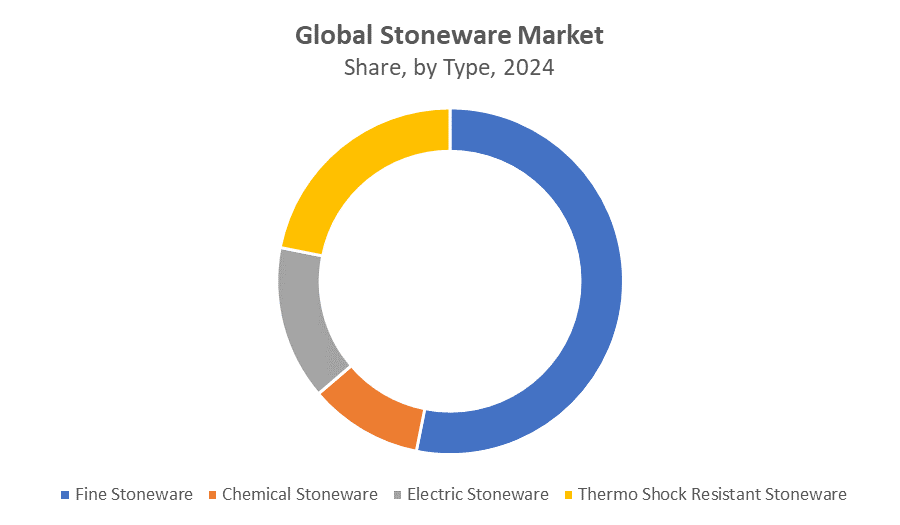
The thermo shock resistant stoneware segment held a significant 21.88% share over the forecast period, driven by its enhanced durability and ability to withstand rapid temperature changes. This makes it especially popular for cookware and tableware used in both domestic and commercial kitchens where items are frequently transferred between hot and cold environments. Consumers value thermo shock resistant stoneware for its reliability, safety, and long-lasting performance, contributing to steady demand and substantial market share within the overall stoneware market.
Global Stoneware Market, By Glaze Stoneware
The salt glaze segment captured the largest revenue share of the stoneware market. Salt glazing creates a distinctive glossy texture and natural variations that are highly valued in both functional and decorative stoneware products. This technique enhances the strength and resistance of the stoneware, making it popular for cookware, tableware, and ornamental pieces. The combination of traditional craftsmanship and modern demand for artisanal, high-quality products has driven the salt glaze segment to lead in revenue within the stoneware market.
The feldspar glaze segment accounted for the leading revenue share over the forecast period. Feldspar acts as a key flux in glazing, improving the finish and strength of stoneware, which makes it highly preferred for both functional and decorative uses. This combination of improved performance and aesthetic appeal drives strong demand, positioning the feldspar glaze segment as a dominant contributor to the stoneware market’s revenue growth.
Asia Pacific accounted for the largest share of the stoneware market during the forecast period, capturing approximately 45%. This dominance is driven by the region’s abundant raw material availability, skilled labor, and growing manufacturing capabilities. Rising disposable incomes, rapid urbanization, and increasing demand for durable and stylish tableware in countries like China and India further fuel market growth. Additionally, expanding hospitality and retail sectors in the region contribute to higher consumption of stoneware products, solidifying Asia Pacific’s leading position in the global market.
India is one of the fastest-growing stoneware markets, growing at 18% annually. This rapid expansion is fueled by rising disposable incomes, increasing urbanization, and a growing middle-class population seeking durable and aesthetically appealing tableware. Additionally, the country’s booming hospitality and retail sectors are driving demand for high-quality stoneware products. Government initiatives supporting local manufacturing and export also contribute to India’s significant growth in the global stoneware market.
Europe is expected to grow at the fastest CAGR of 12% in the stoneware market during the forecast period, driven by increasing consumer preference for premium, eco-friendly, and artisanal stoneware products across the region. Rising awareness about sustainable and durable tableware, along with strong demand from the hospitality and foodservice industries, further fuels market expansion. Additionally, advancements in manufacturing technologies and design innovation in European countries contribute to the rising popularity and faster growth rate of the stoneware market in this region.
Germany is witnessing consistent expansion in the stoneware market, growing at around 8% annually, driven by strong consumer demand for high-quality, durable, and eco-friendly tableware. The country’s well-established hospitality sector and increasing focus on sustainable living further boost market demand. Additionally, innovations in design and manufacturing, coupled with rising disposable incomes, support the ongoing development of Germany’s stoneware market.
WORLDWIDE TOP KEY PLAYERS IN THE STONEWARE MARKET INCLUDE
- Villeroy & Boch AG
- Mikasa & Company
- Denby Pottery Company Ltd.
- Churchill China plc
- Steelite International
- Le Creuset
- Noritake Co., Limited
- Dudson Group
- Royal Doulton
- Portmeirion Group plc
- Others
Product Launches in Stoneware
- In November 2023, Villeroy & Boch introduced a groundbreaking, eco-friendly tableware line crafted from recycled ceramic materials. This innovative collection repurposes production waste and unsold items to create new tableware products, aligning with the growing sustainability trend within the ceramics industry. The launch underscores Villeroy & Boch's commitment to minimizing its environmental footprint while catering to environmentally conscious consumers.
Market Segment
This study forecasts revenue at global, regional, and country levels from 2020 to 2035. Spherical Insights has segmented the stoneware market based on the below-mentioned segments:
Global Stoneware Market, By Type
- Fine Stoneware
- Chemical Stoneware
- Electric Stoneware
- Thermo Shock Resistant Stoneware
Global Stoneware Market, By Glaze Stoneware
- Lead Glaze
- Salt Glaze
- Feldspar Glaze
- Alkali Glaze
Global Stoneware Market, By Regional Analysis
- Asia Pacific
- Europe
- Germany
- UK
- France
- Italy
- Spain
- Russia
- Rest of Europe
- Asia Pacific
- China
- Japan
- India
- South Korea
- Australia
- Rest of Asia Pacific
- South America
- Brazil
- Argentina
- Rest of South America
- Middle East & Africa
- UAE
- Saudi Arabia
- Qatar
- South Africa
- Rest of the Middle East & Africa
FAQs
Q: What is the projected market size of the Global Stoneware Market by 2035?
A: The market size is projected to reach USD 4.09 billion by 2035.
Q: Which region holds the largest market share in the Global Stoneware Market?
A: Asia Pacific is expected to account for the largest share of the stoneware market during the forecast period, capturing approximately 45%.
Q: Which region is expected to grow the fastest in the Global Stoneware Market?
A: Europe is expected to exhibit the fastest growth, with a CAGR of around 12% from 2025 to 2035.
Q: What are the key product types in the Global Stoneware Market, and which leads?
A: The market is segmented into Fine Stoneware, Chemical Stoneware, Electric Stoneware, and Thermo Shock Resistant Stoneware. Fine Stoneware is projected to lead the market, holding approximately 53.13% share.
Q: Which glaze type captures the largest revenue share in the stoneware market?
A: The salt glaze segment holds the largest revenue share due to its distinctive glossy texture and enhanced strength.
Q: What factors are driving growth in the Global Stoneware Market?
A: Increasing disposable incomes, rising urbanization, growing consumer demand for durable and eco-friendly products, technological advancements, government initiatives promoting local manufacturing, and expansion in the hospitality and tourism sectors are key growth drivers.
Q: What challenges are restricting the growth of the stoneware market?
A: High production costs, energy-intensive manufacturing processes, fragility during transportation, competition from cheaper synthetic materials, and limited consumer awareness in some regions pose significant challenges.
Q: What opportunities are available in the stoneware market?
A: Opportunities include collaborations with artists and designers for exclusive collections, innovation in glazing techniques, growing demand for customized products, expansion through e-commerce platforms, and increasing government support for sustainable manufacturing.
Q: Who are the top companies operating in the Global Stoneware Market?
A: Leading players include Villeroy & Boch AG, Mikasa & Company, Denby Pottery Company Ltd., Churchill China plc, Steelite International, Le Creuset, Noritake Co., Limited, Dudson Group, Royal Doulton, and Portmeirion Group plc.
Q: What recent product launches have been seen in the stoneware market?
A: In November 2023, Villeroy & Boch launched an eco-friendly tableware line made from recycled ceramic materials, emphasizing sustainability in product innovation.
Q: What is the outlook for the stoneware market in India?
A: India is one of the fastest-growing stoneware markets, expanding at about 18% annually, driven by rising disposable incomes, urbanization, and growth in hospitality and retail sectors.
Q: How does the Global Stoneware Market ecosystem look?
A: The ecosystem includes raw material suppliers, manufacturers using sustainable technologies, distributors through retail and e-commerce, regulatory bodies enforcing environmental standards, and consumers demanding eco-friendly and stylish products.
